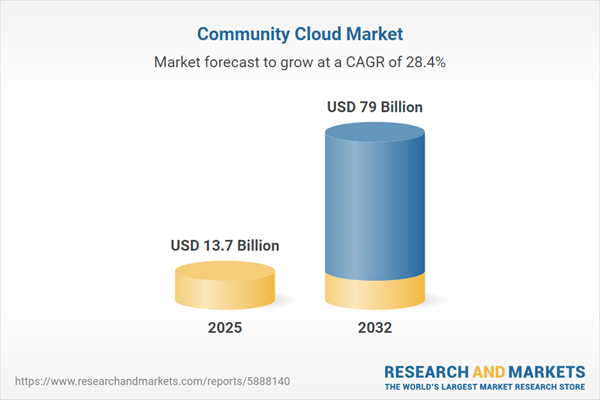Speak directly to the analyst to clarify any post sales queries you may have.
The community cloud market is rapidly evolving, offering organizations a secure and collaborative infrastructure for digital transformation across sectors such as finance, healthcare, and life sciences.
Market Snapshot: Growth and Strategic Momentum in Community Cloud
The Community Cloud Market expanded from USD 10.68 billion in 2024 to USD 13.70 billion in 2025, and is projected to advance at a CAGR of 28.40%, reaching USD 79.00 billion by 2032. This robust growth emphasizes increasing enterprise demand for shared infrastructure that balances collaboration, regulatory alignment, and security. The adoption of community cloud architecture has allowed organizations to pool resources and address complex requirements, positioning the market as a critical enabler of efficient data management and innovation.
Scope & Segmentation: In-Depth Industry and Regional Analysis
- Components: Services (Managed Services including support and training; Professional Services such as consulting and integration), Solutions
- Deployment Type: Hybrid Cloud, Private Cloud, Public Cloud
- Enterprise Size: Large Enterprises, Medium Enterprises, Small Enterprises
- Verticals: Healthcare, Banking/Financial Services/Insurance, Hospitals, Capital Markets, Insurance, Life Sciences
- Geographies: Americas, Europe, Middle East, Africa, Asia-Pacific
- Key Companies: Amazon Web Services, Microsoft, Google, Alibaba, Tencent, IBM, Oracle, Huawei, DigitalOcean, OVHcloud
Within each segment, the report addresses distinctive requirements. For example, capital markets prioritize latency reduction while hospitals focus on rapid deployment and privacy. Regional analysis encompasses advanced economies with mature cloud ecosystems and emerging markets targeting digital inclusion. Technology coverage includes edge computing, zero-trust security models, and open standard protocols to ensure adaptability and compliance.
Key Takeaways for Senior Decision-Makers
- Community cloud adoption is driven by rising regulatory scrutiny and the need for strong data governance, especially in industries where compliance and security are strategic priorities.
- Organizations benefit from cost efficiencies and streamlined performance through resource pooling and standardized platforms managed by trusted third parties or consortiums.
- Enterprises are increasingly choosing hybrid and multi-cloud deployments using community cloud as connective infrastructure, supporting both innovation and operational resilience.
- Dynamic collaboration across institutional and geographic boundaries is enabled by open standards, facilitating the integration of advanced technologies such as artificial intelligence and distributed edge computing.
- Regional success in community cloud hinges on alignment with local regulations, robust ecosystem partnership networks, and the adaptability of service models to varying levels of digital maturity.
Tariff Impact: Navigating Supply Chain and Cost Uncertainties
Recent United States tariff measures introduced in 2025 have added cost pressures on hardware procurement and support for community cloud implementations. In response, organizations have modified sourcing strategies, renegotiated contracts, and pursued regional manufacturing alternatives to manage risks and sustain service quality. These dynamics have underscored the importance of scenario planning and resilient deployment practices in technology procurement and operational models.
Methodology & Data Sources
This report utilizes direct interviews with executives, technology specialists, and compliance professionals, combined with secondary analysis of technical white papers and regulatory materials. Data triangulation and regional validation ensure reliable, current, and actionable insights for the community cloud market.
Why This Report Matters: Strategic Insights for Leadership
- Enable informed technology investment, governance, and security decisions for diverse enterprise contexts.
- Access segment-specific and regional insights to refine go-to-market, procurement, and operational strategies.
- Benchmark your organization’s maturity and future roadmap against peers and top-tier providers navigating shifting regulatory and competitive landscapes.
Conclusion: Navigating the Future of Community Cloud
Community cloud solutions are transforming collaborative frameworks, security postures, and operating models for enterprises worldwide. This report provides the clarity needed for leadership teams to chart strategic paths in a complex, high-growth environment.
Additional Product Information:
- Purchase of this report includes 1 year online access with quarterly updates.
- This report can be updated on request. Please contact our Customer Experience team using the Ask a Question widget on our website.
Table of Contents
3. Executive Summary
4. Market Overview
7. Cumulative Impact of Artificial Intelligence 2025
Companies Mentioned
The companies profiled in this Community Cloud market report include:- Amazon Web Services, Inc.
- Microsoft Corporation
- Google LLC
- Alibaba Group Holding Limited
- Tencent Holdings Limited
- International Business Machines Corporation
- Oracle Corporation
- Huawei Investment & Holding Co., Ltd.
- DigitalOcean Holdings, Inc.
- OVHcloud Inc.
Table Information
| Report Attribute | Details |
|---|---|
| No. of Pages | 185 |
| Published | November 2025 |
| Forecast Period | 2025 - 2032 |
| Estimated Market Value ( USD | $ 13.7 Billion |
| Forecasted Market Value ( USD | $ 79 Billion |
| Compound Annual Growth Rate | 28.4% |
| Regions Covered | Global |
| No. of Companies Mentioned | 11 |









